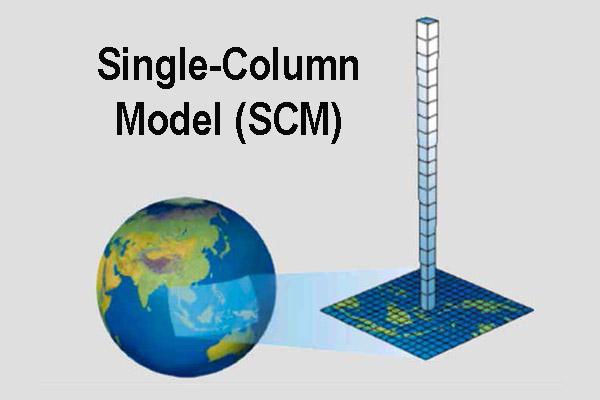Single-Column Model Intercomparison of Diurnal Cycle of Precipitation

A single-column model (SCM) encompasses a vertical column over one grid cell in a model from the surface to the top of the atmosphere.
The Science
The diurnal cycle of precipitation (DCP) is one of the most important temporal variabilities dominated by diurnal variation of solar insolation and regulated by large-scale circulation and mesoscale propagating systems. General Circulation Models (GCM) have for decades exhibited difficulties in modeling DCP. An international multi-model intercomparison project is being organized by the Global Energy and Water EXchanges (GEWEX) Global Atmospheric System Studies (GASS) panel to investigate the interactions between convection and environmental conditions, processes that control nocturnal convections, and the transition from shallow to deep convection on a diurnal timescale. DCP provides an excellent measure of how well climate models simulate not only the total amount of precipitation but also its frequency, intensity, timing, and duration.
Results from the GASS DCP project’s single-column model (SCM) intercomparison have recently been published (Tang et al. 2021). A SCM encompasses a vertical column over one grid cell in a model from the surface to the top of the atmosphere covering one column of a GCM, the results from SCM are also easily comparable to the field measurements from the atmospheric observatory site. Eleven SCM versions of GCMs from eight modeling centers/groups around the world participated in the study.
The Impact
The results of the SCM intercomparison of diurnal cycle of precipitation provide long-term statistical insights into which physical processes are essential and need to be simulated correctly in climate models, in order to reproduce the observational variability of DCP.
Summary
Eleven SCMs are used to study the DCP and related physical processes over two selected continental locations, the U.S. Department of Energy’s Atmospheric Radiation Measurements (ARM) Southern Great Plans (SGP) and the ARM Manacapuru site at the central Amazon (MAO) in Brazil. Precipitation over these two sites is contributed by a few distinct types of convective systems that occur at different time of the day. Two distinct regimes of DCP are examined: one is surface-driven afternoon convection; the other is nocturnal precipitation caused by elevated convection or propagating convective systems. The mean precipitation diurnal cycle at SGP (summer only) peaks at nighttime, while that at MAO peaks in the early afternoon.
As shown in Figure 1, in afternoon precipitation regime, most of the eleven SCMs initiate precipitation 1 to 4 hours earlier than observation. At SGP, the early onset of afternoon precipitation may be due to the missing transition of shallow-to-deep convection in climate models. More sophisticated parameterizations that unify shallow and deep convection better simulate the onset time of precipitation. At MAO, the early onset of precipitation is more severe than at SGP. Models also generate convective heating in a much lower level than derived from observation, and produce rainfall too evenly spread across times of day. In other words, models fail to develop strong deep convection but precipitate too easily from convection in the lower troposphere for the MAO afternoon cases.
For nocturnal precipitation, although all SCMs produce considerable precipitation at night, the partitioning of convective precipitation and large-scale precipitation differ dramatically among models. SCMs with most of the nocturnal precipitation generated from large-scale precipitation are likely driven by the prescribed large-scale forcing. Although models still struggle to propagate convection from one grid to another, those that produce most of nocturnal precipitation from convection all allow convection to be triggered above the boundary layer. This indicates the importance of model capability to detect elevated convection for simulating nocturnal precipitation.
Publication
Tang, S., Xie, S., Guo, Z., Hong, S.-Y., Khouider, B., Klocke, D., et al. (2021) Long-term single-column model intercomparison of diurnal cycle of precipitation over midlatitude and tropical land. Q J R Meteorol Soc, 1– 29, https://doi.org/10.1002/qj.4222.
Funding
- The U.S. Department of Energy Office of Science, Biological and Environmental Research Program supported portions of this research as part of the Regional and Global Model Analysis (RGMA), Atmospheric System Research (ASR), and Earth System Model Development (ESMD) program areas.
- This research used resources of the National Energy Research Scientific Computing Center (NERSC).
- This work by S. Tang, S. Xie, and C. Tao were performed with ARM and ESMD support of the LLNL ARM Infrastructure Project and the E3SM-NGD project.
- This work by H. Ma were performed with RGMA and ASR support of the LLNL PCMDI: An Earth System Model Evaluation Project.
Contact
- Shaocheng Xie, Lawrence Livermore National Laboratory



